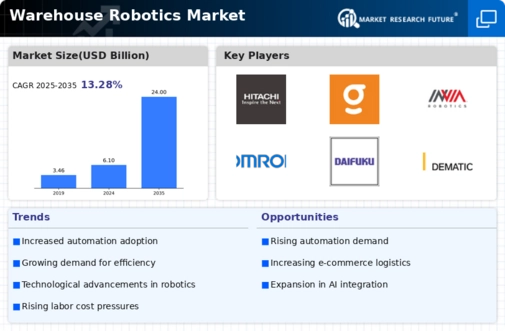-
EXECUTIVE SUMMARY
-
Market Overview
-
Key Findings
-
Market Segmentation
-
Competitive Landscape
-
Challenges and Opportunities
-
Future Outlook
-
\r\n
-
MARKET INTRODUCTION
-
Definition
-
Scope of the study
- Research Objective
- Assumption
- Limitations
-
RESEARCH METHODOLOGY
-
Overview
-
Data Mining
-
Secondary Research
-
Primary Research
- Primary Interviews and Information Gathering Process
- Breakdown of Primary Respondents
-
Forecasting Model
-
Market Size Estimation
- Bottom-Up Approach
- Top-Down Approach
-
Data Triangulation
-
Validation
-
\r\n
-
MARKET DYNAMICS
-
Overview
-
Drivers
-
Restraints
-
Opportunities
-
MARKET FACTOR ANALYSIS
-
Value chain Analysis
-
Porter's Five Forces Analysis
- Bargaining Power of Suppliers
- Bargaining Power of Buyers
- Threat of New Entrants
- Threat of Substitutes
- Intensity of Rivalry
-
COVID-19 Impact Analysis
- Market Impact Analysis
- Regional Impact
- Opportunity and Threat Analysis
-
\r\n
-
WAREHOUSE ROBOTICS MARKET, BY TYPE (USD BILLION)
-
Mobile Robots
-
Articulated Robots
-
Cylindrical Robots
-
SCARA Robots
-
Parallel Robots
-
Cartesian Robots
-
WAREHOUSE ROBOTICS MARKET, BY SOFTWARE (USD BILLION)
-
Warehouse Management System
-
Warehouse Control System
-
Warehouse Execution System
-
WAREHOUSE ROBOTICS MARKET, BY FUNCTION (USD BILLION)
-
Pick & Place
-
Palletizing & De-palletizing
-
Transportation
-
Packaging
-
WAREHOUSE ROBOTICS MARKET, BY REGIONAL (USD BILLION)
-
North America
- US
- Canada
-
Europe
- Germany
- UK
- France
- Russia
- Italy
- Spain
- Rest of Europe
-
APAC
- China
- India
- Japan
- South Korea
- Malaysia
- Thailand
- Indonesia
- Rest of APAC
-
South America
- Brazil
- Mexico
- Argentina
- Rest of South America
-
MEA
- GCC Countries
- South Africa
- Rest of MEA
-
\r\n
-
COMPETITIVE LANDSCAPE
-
Overview
-
Competitive Analysis
-
Market share Analysis
-
Major Growth Strategy in the Warehouse Robotics Market
-
Competitive Benchmarking
-
Leading Players in Terms of Number of Developments in the Warehouse Robotics Market
-
Key developments and growth strategies
- New Product Launch/Service Deployment
- Merger & Acquisitions
- Joint Ventures
-
Major Players Financial Matrix
- Sales and Operating Income
- Major Players R&D Expenditure. 2023
-
COMPANY PROFILES
-
Hitachi
- Financial Overview
- Products Offered
- Key Developments
- SWOT Analysis
- Key Strategies
-
GreyOrange
- Financial Overview
- Products Offered
- Key Developments
- SWOT Analysis
- Key Strategies
-
InVia Robotics
- Financial Overview
- Products Offered
- Key Developments
- SWOT Analysis
- Key Strategies
-
Omron
- Financial Overview
- Products Offered
- Key Developments
- SWOT Analysis
- Key Strategies
-
Daifuku
- Financial Overview
- Products Offered
- Key Developments
- SWOT Analysis
- Key Strategies
-
Dematic
- Financial Overview
- Products Offered
- Key Developments
- SWOT Analysis
- Key Strategies
-
Schaefer Systems International
- Financial Overview
- Products Offered
- Key Developments
- SWOT Analysis
- Key Strategies
-
Locus Robotics
- Financial Overview
- Products Offered
- Key Developments
- SWOT Analysis
- Key Strategies
-
Vecna Robotics
- Financial Overview
- Products Offered
- Key Developments
- SWOT Analysis
- Key Strategies
-
Fetch Robotics
- Financial Overview
- Products Offered
- Key Developments
- SWOT Analysis
- Key Strategies
-
6 River Systems
- Financial Overview
- Products Offered
- Key Developments
- SWOT Analysis
- Key Strategies
-
Robot System Products
- Financial Overview
- Products Offered
- Key Developments
- SWOT Analysis
- Key Strategies
-
Kiva Systems
- Financial Overview
- Products Offered
- Key Developments
- SWOT Analysis
- Key Strategies
-
Fanuc
- Financial Overview
- Products Offered
- Key Developments
- SWOT Analysis
- Key Strategies
-
Amazon Robotics
- Financial Overview
- Products Offered
- Key Developments
- SWOT Analysis
- Key Strategies
-
APPENDIX
-
References
-
Related Reports
-
LIST OF TABLES
-
\r\n
-
LIST OF ASSUMPTIONS
-
NORTH AMERICA WAREHOUSE ROBOTICS MARKET SIZE ESTIMATES & FORECAST, BY TYPE, 2019-2035 (USD BILLIONS)
-
NORTH AMERICA WAREHOUSE ROBOTICS MARKET SIZE ESTIMATES & FORECAST, BY SOFTWARE, 2019-2035 (USD BILLIONS)
-
NORTH AMERICA WAREHOUSE ROBOTICS MARKET SIZE ESTIMATES & FORECAST, BY FUNCTION, 2019-2035 (USD BILLIONS)
-
NORTH AMERICA WAREHOUSE ROBOTICS MARKET SIZE ESTIMATES & FORECAST, BY REGIONAL, 2019-2035 (USD BILLIONS)
-
US WAREHOUSE ROBOTICS MARKET SIZE ESTIMATES & FORECAST, BY TYPE, 2019-2035 (USD BILLIONS)
-
US WAREHOUSE ROBOTICS MARKET SIZE ESTIMATES & FORECAST, BY SOFTWARE, 2019-2035 (USD BILLIONS)
-
US WAREHOUSE ROBOTICS MARKET SIZE ESTIMATES & FORECAST, BY FUNCTION, 2019-2035 (USD BILLIONS)
-
US WAREHOUSE ROBOTICS MARKET SIZE ESTIMATES & FORECAST, BY REGIONAL, 2019-2035 (USD BILLIONS)
-
CANADA WAREHOUSE ROBOTICS MARKET SIZE ESTIMATES & FORECAST, BY TYPE, 2019-2035 (USD BILLIONS)
-
CANADA WAREHOUSE ROBOTICS MARKET SIZE ESTIMATES & FORECAST, BY SOFTWARE, 2019-2035 (USD BILLIONS)
-
CANADA WAREHOUSE ROBOTICS MARKET SIZE ESTIMATES & FORECAST, BY FUNCTION, 2019-2035 (USD BILLIONS)
-
CANADA WAREHOUSE ROBOTICS MARKET SIZE ESTIMATES & FORECAST, BY REGIONAL, 2019-2035 (USD BILLIONS)
-
EUROPE WAREHOUSE ROBOTICS MARKET SIZE ESTIMATES & FORECAST, BY TYPE, 2019-2035 (USD BILLIONS)
-
EUROPE WAREHOUSE ROBOTICS MARKET SIZE ESTIMATES & FORECAST, BY SOFTWARE, 2019-2035 (USD BILLIONS)
-
EUROPE WAREHOUSE ROBOTICS MARKET SIZE ESTIMATES & FORECAST, BY FUNCTION, 2019-2035 (USD BILLIONS)
-
EUROPE WAREHOUSE ROBOTICS MARKET SIZE ESTIMATES & FORECAST, BY REGIONAL, 2019-2035 (USD BILLIONS)
-
GERMANY WAREHOUSE ROBOTICS MARKET SIZE ESTIMATES & FORECAST, BY TYPE, 2019-2035 (USD BILLIONS)
-
GERMANY WAREHOUSE ROBOTICS MARKET SIZE ESTIMATES & FORECAST, BY SOFTWARE, 2019-2035 (USD BILLIONS)
-
GERMANY WAREHOUSE ROBOTICS MARKET SIZE ESTIMATES & FORECAST, BY FUNCTION, 2019-2035 (USD BILLIONS)
-
GERMANY WAREHOUSE ROBOTICS MARKET SIZE ESTIMATES & FORECAST, BY REGIONAL, 2019-2035 (USD BILLIONS)
-
UK WAREHOUSE ROBOTICS MARKET SIZE ESTIMATES & FORECAST, BY TYPE, 2019-2035 (USD BILLIONS)
-
UK WAREHOUSE ROBOTICS MARKET SIZE ESTIMATES & FORECAST, BY SOFTWARE, 2019-2035 (USD BILLIONS)
-
UK WAREHOUSE ROBOTICS MARKET SIZE ESTIMATES & FORECAST, BY FUNCTION, 2019-2035 (USD BILLIONS)
-
UK WAREHOUSE ROBOTICS MARKET SIZE ESTIMATES & FORECAST, BY REGIONAL, 2019-2035 (USD BILLIONS)
-
FRANCE WAREHOUSE ROBOTICS MARKET SIZE ESTIMATES & FORECAST, BY TYPE, 2019-2035 (USD BILLIONS)
-
FRANCE WAREHOUSE ROBOTICS MARKET SIZE ESTIMATES & FORECAST, BY SOFTWARE, 2019-2035 (USD BILLIONS)
-
FRANCE WAREHOUSE ROBOTICS MARKET SIZE ESTIMATES & FORECAST, BY FUNCTION, 2019-2035 (USD BILLIONS)
-
FRANCE WAREHOUSE ROBOTICS MARKET SIZE ESTIMATES & FORECAST, BY REGIONAL, 2019-2035 (USD BILLIONS)
-
RUSSIA WAREHOUSE ROBOTICS MARKET SIZE ESTIMATES & FORECAST, BY TYPE, 2019-2035 (USD BILLIONS)
-
RUSSIA WAREHOUSE ROBOTICS MARKET SIZE ESTIMATES & FORECAST, BY SOFTWARE, 2019-2035 (USD BILLIONS)
-
RUSSIA WAREHOUSE ROBOTICS MARKET SIZE ESTIMATES & FORECAST, BY FUNCTION, 2019-2035 (USD BILLIONS)
-
RUSSIA WAREHOUSE ROBOTICS MARKET SIZE ESTIMATES & FORECAST, BY REGIONAL, 2019-2035 (USD BILLIONS)
-
ITALY WAREHOUSE ROBOTICS MARKET SIZE ESTIMATES & FORECAST, BY TYPE, 2019-2035 (USD BILLIONS)
-
ITALY WAREHOUSE ROBOTICS MARKET SIZE ESTIMATES & FORECAST, BY SOFTWARE, 2019-2035 (USD BILLIONS)
-
ITALY WAREHOUSE ROBOTICS MARKET SIZE ESTIMATES & FORECAST, BY FUNCTION, 2019-2035 (USD BILLIONS)
-
ITALY WAREHOUSE ROBOTICS MARKET SIZE ESTIMATES & FORECAST, BY REGIONAL, 2019-2035 (USD BILLIONS)
-
SPAIN WAREHOUSE ROBOTICS MARKET SIZE ESTIMATES & FORECAST, BY TYPE, 2019-2035 (USD BILLIONS)
-
SPAIN WAREHOUSE ROBOTICS MARKET SIZE ESTIMATES & FORECAST, BY SOFTWARE, 2019-2035 (USD BILLIONS)
-
SPAIN WAREHOUSE ROBOTICS MARKET SIZE ESTIMATES & FORECAST, BY FUNCTION, 2019-2035 (USD BILLIONS)
-
SPAIN WAREHOUSE ROBOTICS MARKET SIZE ESTIMATES & FORECAST, BY REGIONAL, 2019-2035 (USD BILLIONS)
-
REST OF EUROPE WAREHOUSE ROBOTICS MARKET SIZE ESTIMATES & FORECAST, BY TYPE, 2019-2035 (USD BILLIONS)
-
REST OF EUROPE WAREHOUSE ROBOTICS MARKET SIZE ESTIMATES & FORECAST, BY SOFTWARE, 2019-2035 (USD BILLIONS)
-
REST OF EUROPE WAREHOUSE ROBOTICS MARKET SIZE ESTIMATES & FORECAST, BY FUNCTION, 2019-2035 (USD BILLIONS)
-
REST OF EUROPE WAREHOUSE ROBOTICS MARKET SIZE ESTIMATES & FORECAST, BY REGIONAL, 2019-2035 (USD BILLIONS)
-
APAC WAREHOUSE ROBOTICS MARKET SIZE ESTIMATES & FORECAST, BY TYPE, 2019-2035 (USD BILLIONS)
-
APAC WAREHOUSE ROBOTICS MARKET SIZE ESTIMATES & FORECAST, BY SOFTWARE, 2019-2035 (USD BILLIONS)
-
APAC WAREHOUSE ROBOTICS MARKET SIZE ESTIMATES & FORECAST, BY FUNCTION, 2019-2035 (USD BILLIONS)
-
APAC WAREHOUSE ROBOTICS MARKET SIZE ESTIMATES & FORECAST, BY REGIONAL, 2019-2035 (USD BILLIONS)
-
CHINA WAREHOUSE ROBOTICS MARKET SIZE ESTIMATES & FORECAST, BY TYPE, 2019-2035 (USD BILLIONS)
-
CHINA WAREHOUSE ROBOTICS MARKET SIZE ESTIMATES & FORECAST, BY SOFTWARE, 2019-2035 (USD BILLIONS)
-
CHINA WAREHOUSE ROBOTICS MARKET SIZE ESTIMATES & FORECAST, BY FUNCTION, 2019-2035 (USD BILLIONS)
-
CHINA WAREHOUSE ROBOTICS MARKET SIZE ESTIMATES & FORECAST, BY REGIONAL, 2019-2035 (USD BILLIONS)
-
INDIA WAREHOUSE ROBOTICS MARKET SIZE ESTIMATES & FORECAST, BY TYPE, 2019-2035 (USD BILLIONS)
-
INDIA WAREHOUSE ROBOTICS MARKET SIZE ESTIMATES & FORECAST, BY SOFTWARE, 2019-2035 (USD BILLIONS)
-
INDIA WAREHOUSE ROBOTICS MARKET SIZE ESTIMATES & FORECAST, BY FUNCTION, 2019-2035 (USD BILLIONS)
-
INDIA WAREHOUSE ROBOTICS MARKET SIZE ESTIMATES & FORECAST, BY REGIONAL, 2019-2035 (USD BILLIONS)
-
JAPAN WAREHOUSE ROBOTICS MARKET SIZE ESTIMATES & FORECAST, BY TYPE, 2019-2035 (USD BILLIONS)
-
JAPAN WAREHOUSE ROBOTICS MARKET SIZE ESTIMATES & FORECAST, BY SOFTWARE, 2019-2035 (USD BILLIONS)
-
JAPAN WAREHOUSE ROBOTICS MARKET SIZE ESTIMATES & FORECAST, BY FUNCTION, 2019-2035 (USD BILLIONS)
-
JAPAN WAREHOUSE ROBOTICS MARKET SIZE ESTIMATES & FORECAST, BY REGIONAL, 2019-2035 (USD BILLIONS)
-
SOUTH KOREA WAREHOUSE ROBOTICS MARKET SIZE ESTIMATES & FORECAST, BY TYPE, 2019-2035 (USD BILLIONS)
-
SOUTH KOREA WAREHOUSE ROBOTICS MARKET SIZE ESTIMATES & FORECAST, BY SOFTWARE, 2019-2035 (USD BILLIONS)
-
SOUTH KOREA WAREHOUSE ROBOTICS MARKET SIZE ESTIMATES & FORECAST, BY FUNCTION, 2019-2035 (USD BILLIONS)
-
SOUTH KOREA WAREHOUSE ROBOTICS MARKET SIZE ESTIMATES & FORECAST, BY REGIONAL, 2019-2035 (USD BILLIONS)
-
MALAYSIA WAREHOUSE ROBOTICS MARKET SIZE ESTIMATES & FORECAST, BY TYPE, 2019-2035 (USD BILLIONS)
-
MALAYSIA WAREHOUSE ROBOTICS MARKET SIZE ESTIMATES & FORECAST, BY SOFTWARE, 2019-2035 (USD BILLIONS)
-
MALAYSIA WAREHOUSE ROBOTICS MARKET SIZE ESTIMATES & FORECAST, BY FUNCTION, 2019-2035 (USD BILLIONS)
-
MALAYSIA WAREHOUSE ROBOTICS MARKET SIZE ESTIMATES & FORECAST, BY REGIONAL, 2019-2035 (USD BILLIONS)
-
THAILAND WAREHOUSE ROBOTICS MARKET SIZE ESTIMATES & FORECAST, BY TYPE, 2019-2035 (USD BILLIONS)
-
THAILAND WAREHOUSE ROBOTICS MARKET SIZE ESTIMATES & FORECAST, BY SOFTWARE, 2019-2035 (USD BILLIONS)
-
THAILAND WAREHOUSE ROBOTICS MARKET SIZE ESTIMATES & FORECAST, BY FUNCTION, 2019-2035 (USD BILLIONS)
-
THAILAND WAREHOUSE ROBOTICS MARKET SIZE ESTIMATES & FORECAST, BY REGIONAL, 2019-2035 (USD BILLIONS)
-
INDONESIA WAREHOUSE ROBOTICS MARKET SIZE ESTIMATES & FORECAST, BY TYPE, 2019-2035 (USD BILLIONS)
-
INDONESIA WAREHOUSE ROBOTICS MARKET SIZE ESTIMATES & FORECAST, BY SOFTWARE, 2019-2035 (USD BILLIONS)
-
INDONESIA WAREHOUSE ROBOTICS MARKET SIZE ESTIMATES & FORECAST, BY FUNCTION, 2019-2035 (USD BILLIONS)
-
INDONESIA WAREHOUSE ROBOTICS MARKET SIZE ESTIMATES & FORECAST, BY REGIONAL, 2019-2035 (USD BILLIONS)
-
REST OF APAC WAREHOUSE ROBOTICS MARKET SIZE ESTIMATES & FORECAST, BY TYPE, 2019-2035 (USD BILLIONS)
-
REST OF APAC WAREHOUSE ROBOTICS MARKET SIZE ESTIMATES & FORECAST, BY SOFTWARE, 2019-2035 (USD BILLIONS)
-
REST OF APAC WAREHOUSE ROBOTICS MARKET SIZE ESTIMATES & FORECAST, BY FUNCTION, 2019-2035 (USD BILLIONS)
-
REST OF APAC WAREHOUSE ROBOTICS MARKET SIZE ESTIMATES & FORECAST, BY REGIONAL, 2019-2035 (USD BILLIONS)
-
SOUTH AMERICA WAREHOUSE ROBOTICS MARKET SIZE ESTIMATES & FORECAST, BY TYPE, 2019-2035 (USD BILLIONS)
-
SOUTH AMERICA WAREHOUSE ROBOTICS MARKET SIZE ESTIMATES & FORECAST, BY SOFTWARE, 2019-2035 (USD BILLIONS)
-
SOUTH AMERICA WAREHOUSE ROBOTICS MARKET SIZE ESTIMATES & FORECAST, BY FUNCTION, 2019-2035 (USD BILLIONS)
-
SOUTH AMERICA WAREHOUSE ROBOTICS MARKET SIZE ESTIMATES & FORECAST, BY REGIONAL, 2019-2035 (USD BILLIONS)
-
BRAZIL WAREHOUSE ROBOTICS MARKET SIZE ESTIMATES & FORECAST, BY TYPE, 2019-2035 (USD BILLIONS)
-
BRAZIL WAREHOUSE ROBOTICS MARKET SIZE ESTIMATES & FORECAST, BY SOFTWARE, 2019-2035 (USD BILLIONS)
-
BRAZIL WAREHOUSE ROBOTICS MARKET SIZE ESTIMATES & FORECAST, BY FUNCTION, 2019-2035 (USD BILLIONS)
-
BRAZIL WAREHOUSE ROBOTICS MARKET SIZE ESTIMATES & FORECAST, BY REGIONAL, 2019-2035 (USD BILLIONS)
-
MEXICO WAREHOUSE ROBOTICS MARKET SIZE ESTIMATES & FORECAST, BY TYPE, 2019-2035 (USD BILLIONS)
-
MEXICO WAREHOUSE ROBOTICS MARKET SIZE ESTIMATES & FORECAST, BY SOFTWARE, 2019-2035 (USD BILLIONS)
-
MEXICO WAREHOUSE ROBOTICS MARKET SIZE ESTIMATES & FORECAST, BY FUNCTION, 2019-2035 (USD BILLIONS)
-
MEXICO WAREHOUSE ROBOTICS MARKET SIZE ESTIMATES & FORECAST, BY REGIONAL, 2019-2035 (USD BILLIONS)
-
ARGENTINA WAREHOUSE ROBOTICS MARKET SIZE ESTIMATES & FORECAST, BY TYPE, 2019-2035 (USD BILLIONS)
-
ARGENTINA WAREHOUSE ROBOTICS MARKET SIZE ESTIMATES & FORECAST, BY SOFTWARE, 2019-2035 (USD BILLIONS)
-
ARGENTINA WAREHOUSE ROBOTICS MARKET SIZE ESTIMATES & FORECAST, BY FUNCTION, 2019-2035 (USD BILLIONS)
-
ARGENTINA WAREHOUSE ROBOTICS MARKET SIZE ESTIMATES & FORECAST, BY REGIONAL, 2019-2035 (USD BILLIONS)
-
REST OF SOUTH AMERICA WAREHOUSE ROBOTICS MARKET SIZE ESTIMATES & FORECAST, BY TYPE, 2019-2035 (USD BILLIONS)
-
REST OF SOUTH AMERICA WAREHOUSE ROBOTICS MARKET SIZE ESTIMATES & FORECAST, BY SOFTWARE, 2019-2035 (USD BILLIONS)
-
REST OF SOUTH AMERICA WAREHOUSE ROBOTICS MARKET SIZE ESTIMATES & FORECAST, BY FUNCTION, 2019-2035 (USD BILLIONS)
-
REST OF SOUTH AMERICA WAREHOUSE ROBOTICS MARKET SIZE ESTIMATES & FORECAST, BY REGIONAL, 2019-2035 (USD BILLIONS)
-
MEA WAREHOUSE ROBOTICS MARKET SIZE ESTIMATES & FORECAST, BY TYPE, 2019-2035 (USD BILLIONS)
-
MEA WAREHOUSE ROBOTICS MARKET SIZE ESTIMATES & FORECAST, BY SOFTWARE, 2019-2035 (USD BILLIONS)
-
MEA WAREHOUSE ROBOTICS MARKET SIZE ESTIMATES & FORECAST, BY FUNCTION, 2019-2035 (USD BILLIONS)
-
MEA WAREHOUSE ROBOTICS MARKET SIZE ESTIMATES & FORECAST, BY REGIONAL, 2019-2035 (USD BILLIONS)
-
GCC COUNTRIES WAREHOUSE ROBOTICS MARKET SIZE ESTIMATES & FORECAST, BY TYPE, 2019-2035 (USD BILLIONS)
-
GCC COUNTRIES WAREHOUSE ROBOTICS MARKET SIZE ESTIMATES & FORECAST, BY SOFTWARE, 2019-2035 (USD BILLIONS)
-
GCC COUNTRIES WAREHOUSE ROBOTICS MARKET SIZE ESTIMATES & FORECAST, BY FUNCTION, 2019-2035 (USD BILLIONS)
-
GCC COUNTRIES WAREHOUSE ROBOTICS MARKET SIZE ESTIMATES & FORECAST, BY REGIONAL, 2019-2035 (USD BILLIONS)
-
SOUTH AFRICA WAREHOUSE ROBOTICS MARKET SIZE ESTIMATES & FORECAST, BY TYPE, 2019-2035 (USD BILLIONS)
-
SOUTH AFRICA WAREHOUSE ROBOTICS MARKET SIZE ESTIMATES & FORECAST, BY SOFTWARE, 2019-2035 (USD BILLIONS)
-
SOUTH AFRICA WAREHOUSE ROBOTICS MARKET SIZE ESTIMATES & FORECAST, BY FUNCTION, 2019-2035 (USD BILLIONS)
-
SOUTH AFRICA WAREHOUSE ROBOTICS MARKET SIZE ESTIMATES & FORECAST, BY REGIONAL, 2019-2035 (USD BILLIONS)
-
REST OF MEA WAREHOUSE ROBOTICS MARKET SIZE ESTIMATES & FORECAST, BY TYPE, 2019-2035 (USD BILLIONS)
-
REST OF MEA WAREHOUSE ROBOTICS MARKET SIZE ESTIMATES & FORECAST, BY SOFTWARE, 2019-2035 (USD BILLIONS)
-
REST OF MEA WAREHOUSE ROBOTICS MARKET SIZE ESTIMATES & FORECAST, BY FUNCTION, 2019-2035 (USD BILLIONS)
-
REST OF MEA WAREHOUSE ROBOTICS MARKET SIZE ESTIMATES & FORECAST, BY REGIONAL, 2019-2035 (USD BILLIONS)
-
PRODUCT LAUNCH/PRODUCT DEVELOPMENT/APPROVAL
-
ACQUISITION/PARTNERSHIP
-
\r\n
-
\r\n
-
\r\n
-
\r\n
-
\r\n
-
\r\n
-
\r\n
-
\r\n
-
\r\n
-
\r\n
-
\r\n
-
\r\n
-
\r\n
-
\r\n
-
\r\n
-
LIST OF FIGURES
-
\r\n
-
MARKET SYNOPSIS
-
NORTH AMERICA WAREHOUSE ROBOTICS MARKET ANALYSIS
-
US WAREHOUSE ROBOTICS MARKET ANALYSIS BY TYPE
-
US WAREHOUSE ROBOTICS MARKET ANALYSIS BY SOFTWARE
-
US WAREHOUSE ROBOTICS MARKET ANALYSIS BY FUNCTION
-
US WAREHOUSE ROBOTICS MARKET ANALYSIS BY REGIONAL
-
CANADA WAREHOUSE ROBOTICS MARKET ANALYSIS BY TYPE
-
CANADA WAREHOUSE ROBOTICS MARKET ANALYSIS BY SOFTWARE
-
CANADA WAREHOUSE ROBOTICS MARKET ANALYSIS BY FUNCTION
-
CANADA WAREHOUSE ROBOTICS MARKET ANALYSIS BY REGIONAL
-
EUROPE WAREHOUSE ROBOTICS MARKET ANALYSIS
-
GERMANY WAREHOUSE ROBOTICS MARKET ANALYSIS BY TYPE
-
GERMANY WAREHOUSE ROBOTICS MARKET ANALYSIS BY SOFTWARE
-
GERMANY WAREHOUSE ROBOTICS MARKET ANALYSIS BY FUNCTION
-
GERMANY WAREHOUSE ROBOTICS MARKET ANALYSIS BY REGIONAL
-
UK WAREHOUSE ROBOTICS MARKET ANALYSIS BY TYPE
-
UK WAREHOUSE ROBOTICS MARKET ANALYSIS BY SOFTWARE
-
UK WAREHOUSE ROBOTICS MARKET ANALYSIS BY FUNCTION
-
UK WAREHOUSE ROBOTICS MARKET ANALYSIS BY REGIONAL
-
FRANCE WAREHOUSE ROBOTICS MARKET ANALYSIS BY TYPE
-
FRANCE WAREHOUSE ROBOTICS MARKET ANALYSIS BY SOFTWARE
-
FRANCE WAREHOUSE ROBOTICS MARKET ANALYSIS BY FUNCTION
-
FRANCE WAREHOUSE ROBOTICS MARKET ANALYSIS BY REGIONAL
-
RUSSIA WAREHOUSE ROBOTICS MARKET ANALYSIS BY TYPE
-
RUSSIA WAREHOUSE ROBOTICS MARKET ANALYSIS BY SOFTWARE
-
RUSSIA WAREHOUSE ROBOTICS MARKET ANALYSIS BY FUNCTION
-
RUSSIA WAREHOUSE ROBOTICS MARKET ANALYSIS BY REGIONAL
-
ITALY WAREHOUSE ROBOTICS MARKET ANALYSIS BY TYPE
-
ITALY WAREHOUSE ROBOTICS MARKET ANALYSIS BY SOFTWARE
-
ITALY WAREHOUSE ROBOTICS MARKET ANALYSIS BY FUNCTION
-
ITALY WAREHOUSE ROBOTICS MARKET ANALYSIS BY REGIONAL
-
SPAIN WAREHOUSE ROBOTICS MARKET ANALYSIS BY TYPE
-
SPAIN WAREHOUSE ROBOTICS MARKET ANALYSIS BY SOFTWARE
-
SPAIN WAREHOUSE ROBOTICS MARKET ANALYSIS BY FUNCTION
-
SPAIN WAREHOUSE ROBOTICS MARKET ANALYSIS BY REGIONAL
-
REST OF EUROPE WAREHOUSE ROBOTICS MARKET ANALYSIS BY TYPE
-
REST OF EUROPE WAREHOUSE ROBOTICS MARKET ANALYSIS BY SOFTWARE
-
REST OF EUROPE WAREHOUSE ROBOTICS MARKET ANALYSIS BY FUNCTION
-
REST OF EUROPE WAREHOUSE ROBOTICS MARKET ANALYSIS BY REGIONAL
-
APAC WAREHOUSE ROBOTICS MARKET ANALYSIS
-
CHINA WAREHOUSE ROBOTICS MARKET ANALYSIS BY TYPE
-
CHINA WAREHOUSE ROBOTICS MARKET ANALYSIS BY SOFTWARE
-
CHINA WAREHOUSE ROBOTICS MARKET ANALYSIS BY FUNCTION
-
CHINA WAREHOUSE ROBOTICS MARKET ANALYSIS BY REGIONAL
-
INDIA WAREHOUSE ROBOTICS MARKET ANALYSIS BY TYPE
-
INDIA WAREHOUSE ROBOTICS MARKET ANALYSIS BY SOFTWARE
-
INDIA WAREHOUSE ROBOTICS MARKET ANALYSIS BY FUNCTION
-
INDIA WAREHOUSE ROBOTICS MARKET ANALYSIS BY REGIONAL
-
JAPAN WAREHOUSE ROBOTICS MARKET ANALYSIS BY TYPE
-
JAPAN WAREHOUSE ROBOTICS MARKET ANALYSIS BY SOFTWARE
-
JAPAN WAREHOUSE ROBOTICS MARKET ANALYSIS BY FUNCTION
-
JAPAN WAREHOUSE ROBOTICS MARKET ANALYSIS BY REGIONAL
-
SOUTH KOREA WAREHOUSE ROBOTICS MARKET ANALYSIS BY TYPE
-
SOUTH KOREA WAREHOUSE ROBOTICS MARKET ANALYSIS BY SOFTWARE
-
SOUTH KOREA WAREHOUSE ROBOTICS MARKET ANALYSIS BY FUNCTION
-
SOUTH KOREA WAREHOUSE ROBOTICS MARKET ANALYSIS BY REGIONAL
-
MALAYSIA WAREHOUSE ROBOTICS MARKET ANALYSIS BY TYPE
-
MALAYSIA WAREHOUSE ROBOTICS MARKET ANALYSIS BY SOFTWARE
-
MALAYSIA WAREHOUSE ROBOTICS MARKET ANALYSIS BY FUNCTION
-
MALAYSIA WAREHOUSE ROBOTICS MARKET ANALYSIS BY REGIONAL
-
THAILAND WAREHOUSE ROBOTICS MARKET ANALYSIS BY TYPE
-
THAILAND WAREHOUSE ROBOTICS MARKET ANALYSIS BY SOFTWARE
-
THAILAND WAREHOUSE ROBOTICS MARKET ANALYSIS BY FUNCTION
-
THAILAND WAREHOUSE ROBOTICS MARKET ANALYSIS BY REGIONAL
-
INDONESIA WAREHOUSE ROBOTICS MARKET ANALYSIS BY TYPE
-
INDONESIA WAREHOUSE ROBOTICS MARKET ANALYSIS BY SOFTWARE
-
INDONESIA WAREHOUSE ROBOTICS MARKET ANALYSIS BY FUNCTION
-
INDONESIA WAREHOUSE ROBOTICS MARKET ANALYSIS BY REGIONAL
-
REST OF APAC WAREHOUSE ROBOTICS MARKET ANALYSIS BY TYPE
-
REST OF APAC WAREHOUSE ROBOTICS MARKET ANALYSIS BY SOFTWARE
-
REST OF APAC WAREHOUSE ROBOTICS MARKET ANALYSIS BY FUNCTION
-
REST OF APAC WAREHOUSE ROBOTICS MARKET ANALYSIS BY REGIONAL
-
SOUTH AMERICA WAREHOUSE ROBOTICS MARKET ANALYSIS
-
BRAZIL WAREHOUSE ROBOTICS MARKET ANALYSIS BY TYPE
-
BRAZIL WAREHOUSE ROBOTICS MARKET ANALYSIS BY SOFTWARE
-
BRAZIL WAREHOUSE ROBOTICS MARKET ANALYSIS BY FUNCTION
-
BRAZIL WAREHOUSE ROBOTICS MARKET ANALYSIS BY REGIONAL
-
MEXICO WAREHOUSE ROBOTICS MARKET ANALYSIS BY TYPE
-
MEXICO WAREHOUSE ROBOTICS MARKET ANALYSIS BY SOFTWARE
-
MEXICO WAREHOUSE ROBOTICS MARKET ANALYSIS BY FUNCTION
-
MEXICO WAREHOUSE ROBOTICS MARKET ANALYSIS BY REGIONAL
-
ARGENTINA WAREHOUSE ROBOTICS MARKET ANALYSIS BY TYPE
-
ARGENTINA WAREHOUSE ROBOTICS MARKET ANALYSIS BY SOFTWARE
-
ARGENTINA WAREHOUSE ROBOTICS MARKET ANALYSIS BY FUNCTION
-
ARGENTINA WAREHOUSE ROBOTICS MARKET ANALYSIS BY REGIONAL
-
REST OF SOUTH AMERICA WAREHOUSE ROBOTICS MARKET ANALYSIS BY TYPE
-
REST OF SOUTH AMERICA WAREHOUSE ROBOTICS MARKET ANALYSIS BY SOFTWARE
-
REST OF SOUTH AMERICA WAREHOUSE ROBOTICS MARKET ANALYSIS BY FUNCTION
-
REST OF SOUTH AMERICA WAREHOUSE ROBOTICS MARKET ANALYSIS BY REGIONAL
-
MEA WAREHOUSE ROBOTICS MARKET ANALYSIS
-
GCC COUNTRIES WAREHOUSE ROBOTICS MARKET ANALYSIS BY TYPE
-
GCC COUNTRIES WAREHOUSE ROBOTICS MARKET ANALYSIS BY SOFTWARE
-
GCC COUNTRIES WAREHOUSE ROBOTICS MARKET ANALYSIS BY FUNCTION
-
GCC COUNTRIES WAREHOUSE ROBOTICS MARKET ANALYSIS BY REGIONAL
-
SOUTH AFRICA WAREHOUSE ROBOTICS MARKET ANALYSIS BY TYPE
-
SOUTH AFRICA WAREHOUSE ROBOTICS MARKET ANALYSIS BY SOFTWARE
-
SOUTH AFRICA WAREHOUSE ROBOTICS MARKET ANALYSIS BY FUNCTION
-
SOUTH AFRICA WAREHOUSE ROBOTICS MARKET ANALYSIS BY REGIONAL
-
REST OF MEA WAREHOUSE ROBOTICS MARKET ANALYSIS BY TYPE
-
REST OF MEA WAREHOUSE ROBOTICS MARKET ANALYSIS BY SOFTWARE
-
REST OF MEA WAREHOUSE ROBOTICS MARKET ANALYSIS BY FUNCTION
-
REST OF MEA WAREHOUSE ROBOTICS MARKET ANALYSIS BY REGIONAL
-
KEY BUYING CRITERIA OF WAREHOUSE ROBOTICS MARKET
-
RESEARCH PROCESS OF MRFR
-
DRO ANALYSIS OF WAREHOUSE ROBOTICS MARKET
-
DRIVERS IMPACT ANALYSIS: WAREHOUSE ROBOTICS MARKET
-
RESTRAINTS IMPACT ANALYSIS: WAREHOUSE ROBOTICS MARKET
-
SUPPLY / VALUE CHAIN: WAREHOUSE ROBOTICS MARKET
-
WAREHOUSE ROBOTICS MARKET, BY TYPE, 2025 (% SHARE)
-
WAREHOUSE ROBOTICS MARKET, BY TYPE, 2019 TO 2035 (USD Billions)
-
WAREHOUSE ROBOTICS MARKET, BY SOFTWARE, 2025 (% SHARE)
-
WAREHOUSE ROBOTICS MARKET, BY SOFTWARE, 2019 TO 2035 (USD Billions)
-
WAREHOUSE ROBOTICS MARKET, BY FUNCTION, 2025 (% SHARE)
-
WAREHOUSE ROBOTICS MARKET, BY FUNCTION, 2019 TO 2035 (USD Billions)
-
WAREHOUSE ROBOTICS MARKET, BY REGIONAL, 2025 (% SHARE)
-
WAREHOUSE ROBOTICS MARKET, BY REGIONAL, 2019 TO 2035 (USD Billions)
-
BENCHMARKING OF MAJOR COMPETITOR
-
"








Leave a Comment